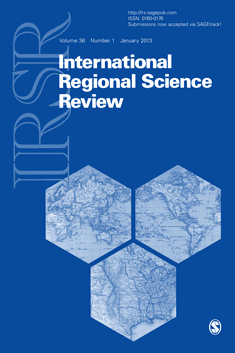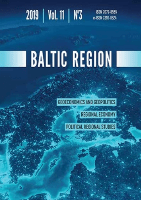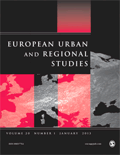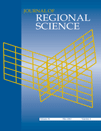
Regional Statistics
Scope & Guideline
Exploring the Quantitative Dimensions of Society
Introduction
Aims and Scopes
- Regional Economic Analysis:
The journal explores economic trends and disparities at the regional level, analyzing factors that influence economic performance, such as labor markets, income distribution, and investment patterns. - Social and Demographic Studies:
It emphasizes the study of demographic changes, migration patterns, and their implications on regional development and well-being. - Spatial Analysis and Modeling:
Utilizing advanced statistical and computational methods, the journal focuses on spatial patterns and the interrelationship between different regions, contributing to the understanding of geographic dynamics. - Health and Quality of Life Assessments:
The journal includes studies on healthcare systems, public health, and quality of life indicators, aiming to highlight regional health disparities and their determinants. - Sustainability and Environmental Impact:
There is a significant focus on sustainability issues, including the effects of economic activities on the environment and the analysis of policies aimed at promoting sustainable regional development.
Trending and Emerging
- Impact of COVID-19 on Regional Dynamics:
A significant number of studies focus on the effects of the COVID-19 pandemic on various aspects of regional economies, labor markets, and public health, highlighting the ongoing relevance of this global crisis. - Green Economy and Sustainability:
Emerging themes include the analysis of environmental sustainability, green technologies, and their economic impacts, indicating a growing emphasis on sustainable development and ecological considerations. - Migration and Urbanization Trends:
There is an increasing focus on migration patterns, urbanization processes, and their socio-economic implications, reflecting the complexities of demographic shifts in a globalized world. - Technological Change and Regional Development:
Research exploring the relationship between technological advancements, innovation, and regional economic performance is gaining traction, emphasizing the role of technology in shaping future regional dynamics. - Inequality and Social Justice:
Studies addressing income inequality, social justice, and their spatial dimensions are becoming more prominent, reflecting a heightened awareness of socio-economic disparities and the need for inclusive policies.
Declining or Waning
- Historical Economic Analyses:
While historical analyses of economic development were once more prevalent, there has been a noticeable decline in studies focusing solely on historical economic contexts, possibly due to the increasing emphasis on contemporary issues. - Single-Dimensional Studies:
Research that focuses on a single dimension of regional analysis, such as purely economic or demographic factors, has become less common as the journal increasingly favors interdisciplinary approaches. - Local Case Studies with Limited Generalizability:
There has been a waning interest in highly localized case studies that do not provide broader insights or implications for regional policy, reflecting a shift towards research that offers comparative analysis across multiple regions.
Similar Journals

Review of Regional Research-Jahrbuch fur Regionalwissenschaft
Advancing Regional Insights for a Sustainable FutureReview of Regional Research-Jahrbuch fur Regionalwissenschaft, published by SPRINGER HEIDELBERG, is a pivotal academic journal dedicated to the interdisciplinary exploration of regional science, economics, and geographical studies. With a strong presence in Germany and an impressive range of topics, this journal serves as a vital platform for scholars, researchers, and practitioners aiming to advance knowledge in regional development and planning. The journal has achieved notable recognition, being categorized in the Q3 quartile in Economics and Econometrics and Q2 in both Geography, Planning and Development and Social Sciences (miscellaneous), highlighting its importance in contemporary academic discourse. The Scopus rankings further affirm its relevance, with an impressive percentile ranking across its categories. Although it operates under traditional access options, the journal's robust editorial oversight ensures high-quality research dissemination from 1998 through 2024, making it essential for anyone invested in the critical dynamics of regional studies.

Geographical Review of Japan-Series B
Illuminating the Socio-Economic Landscapes of JapanGeographical Review of Japan-Series B, an esteemed publication by the Association of Japanese Geographers, serves as a vital platform for scholarly discourse in the field of geography, focusing on the nuanced socio-economic and environmental dynamics of Japan. With the ISSN 1883-4396, this journal aims to publish rigorous, peer-reviewed research that contributes to understanding Japan's geographic phenomena and informing policy-making. Although it is not an open-access journal, it provides insights accessible to researchers, professionals, and students seeking a deeper engagement with regional and international geographical discussions. With its commitment to excellence in academic contribution, the Geographical Review of Japan-Series B remains an essential resource for those dedicated to advancing geographical knowledge in Japan and beyond.

INTERNATIONAL REGIONAL SCIENCE REVIEW
Uncovering innovative solutions for regional challenges.INTERNATIONAL REGIONAL SCIENCE REVIEW, published by SAGE Publications Inc, is a premier academic journal dedicated to advancing the field of regional science through rigorous empirical and theoretical research. With an ISSN of 0160-0176 and an E-ISSN of 1552-6925, this journal has earned its place in the scholarly community, boasting a Q1 ranking in Social Sciences and a Q2 ranking in Environmental Science as of 2023, reflecting its high impact and contribution to both domains. Covering a wide array of topics from urban development to environmental policy, the journal's eclectic scope attracts a diverse audience of researchers, practitioners, and students interested in understanding the dynamics of regional development and planning. Although not an open-access journal, the importance of its contributions is underscored by its strong Scopus rankings—45th in General Social Sciences and 80th in General Environmental Science. With a history that converges from 1975 to the present, INTERNATIONAL REGIONAL SCIENCE REVIEW remains an essential resource for those seeking to explore the complexities of regional challenges and innovations.

Area Development and Policy
Shaping urban landscapes through innovative policy discourse.Area Development and Policy is a prominent open-access journal published by Routledge Journals, Taylor & Francis Ltd, focusing on significant contributions to the fields of geography, urban studies, public administration, and environmental science. Launched in 2014 and located in the United Kingdom, this journal has quickly garnered a reputation for excellence, achieving a Q1 ranking in several categories, including Geography, Planning and Development, and Nature and Landscape Conservation as of 2023. Researchers and academics benefit from its broad scope, which encompasses various dimensions of area development and policy-making, while facilitating the dissemination of cutting-edge research through its open-access format. With an exceptional Scopus ranking—particularly within Urban Studies (#32/279)—the journal serves as a crucial platform for scholars seeking to advance discourse in these fields. As it converges its focus through 2024 and beyond, Area Development and Policy continues to be an essential resource for professionals and students dedicated to understanding the complexities of regional development and the policies that shape our environments.

Baltic Region
Fostering Global Dialogue Through Baltic ResearchBaltic Region is a prominent academic journal published by the Immanuel Kant Baltic Federal University, dedicated to advancing scholarship across multiple disciplinary fields including Cultural Studies, Economics, History, Sociology, and Geography. Established in 2009 as an open-access publication, Baltic Region provides a vital platform for researchers and scholars to disseminate their findings, fostering interdisciplinary dialogue and collaboration among academics worldwide. With an impressive Q1 ranking in Cultural Studies and History, and its presence in the esteemed Scopus database reflecting high percentiles in various social science categories, the journal has established itself as a key resource in understanding the complexities of the Baltic region and beyond. Based in Kaliningrad, Russia, it aims to bridge gaps in knowledge through rigorous peer-reviewed research, making it an essential tool for students, professionals, and researchers committed to exploring societal and economic issues of the contemporary world.

EUROPEAN URBAN AND REGIONAL STUDIES
Fostering Dialogue on Urban Sustainability and PolicyEUROPEAN URBAN AND REGIONAL STUDIES is a premier journal dedicated to advancing the field of urban and regional studies, published by SAGE PUBLICATIONS LTD, a distinguished publisher renowned for its contributions to scholarly communications. Established in 1994 and running through 2024, this journal provides a vital platform for interdisciplinary research that addresses the complexities of urban environments and regional developments across Europe and beyond. It holds impressive distinctions, ranking in the Q1 category for both Environmental Science and Urban Studies in 2023, reflecting its strong impact and influence—ranked #31 out of 279 and #42 out of 219 in Scopus, respectively. Scholars and practitioners seeking to contribute to or stay informed on trends in sustainable urban development, policy-making, and regional planning will find this journal indispensable. Its contributions not only shed light on pressing urban issues but also cultivate a dialogue that bridges theory and practice. Enhance your understanding of contemporary urban challenges by engaging with the rich tapestry of research published in this esteemed journal.

Regionologiya-Regionology Russian Journal of Regional Studies
Cultivating interdisciplinary dialogue for regional progress.Regionologiya-Regionology: Russian Journal of Regional Studies, published by the NATIONAL RESEARCH OGAREV MORDOVIA STATE UNIVERSITY, serves as a pivotal platform for scholars dedicated to advancing the field of regional studies. With an ISSN of 2413-1407 and an E-ISSN of 2587-8549, this Open Access journal has been committed to disseminating high-quality research since its inception in 1992, allowing unrestricted access to a diverse array of studies relevant to regional development, policy analysis, and socioeconomic dynamics. Positioned within a global network of researchers, Regionologiya-Regionology not only explores emerging trends and methodologies but also emphasizes the importance of regional identity and its cultivation in the contemporary world. By fostering interdisciplinary dialogue and collaboration, the journal aims to equip researchers, professionals, and students alike with valuable insights and findings that contribute to an enhanced understanding of regional issues and innovative solutions.

Review of Regional Studies
Bridging theory and application in regional science.Review of Regional Studies, published by the SOUTHERN REGIONAL SCIENCE ASSOCIATION, is an open-access academic journal dedicated to advancing knowledge in the fields of regional science, geography, and planning. With an ISSN of 0048-749X and E-ISSN 1553-0892, this journal has made its contributions widely available online since 2011, ensuring accessibility for a global audience. The journal features a broad scope encompassing regional studies, aligning with current trends in environmental and urban research. Notably positioned within Q3 for both Earth-Surface Processes and Geography, Planning and Development categories for 2023, it presents rigorous analyses and insights from 1977 to the present, engaging researchers, practitioners, and students alike. Its rankings reflect its evolving impact in the social sciences and earth sciences, making it a vital resource for those interested in understanding the intricate dynamics of regional development and spatial interactions.

JOURNAL OF REGIONAL SCIENCE
Innovating Solutions for Sustainable Regional GrowthJOURNAL OF REGIONAL SCIENCE, published by Wiley, stands as a leading forum for the dissemination of innovative research in the fields of regional development and environmental science. With an impactful presence since 1958, this highly regarded journal boasts a robust ranking within the Q1 category in both Development and Environmental Science (miscellaneous), reflecting its influence and importance in these domains. Researchers can explore a wealth of critical studies that address diverse issues impacting regions across the globe, facilitating multidisciplinary dialogue essential for addressing contemporary challenges. The journal is indexed with an impact factor that underscores its scholarly significance, rendering it an indispensable resource for professionals, researchers, and students seeking to engage with cutting-edge developments in regional science. Although it does not operate under an Open Access model, the wealth of insights offered continues to contribute substantially to the field.

Revista de Estudios Regionales
Advancing Knowledge in Social Sciences.Revista de Estudios Regionales is a distinguished academic journal published by ASOC UNIV PUBLICAS ANDALUCIA-AUPA, focusing on various fundamental areas in the social sciences, including development, economics, sociology, and political science. Established in 1978 and converging its publication years to include recent contributions until 2024, the journal serves as a critical platform for international scholars and practitioners interested in the regional dynamics of Spain and beyond. Despite its current Q4 ranking in key categories such as Development, Economics, and Sociology, the journal aims to elevate discourse and foster a deeper understanding of regional studies, ultimately contributing to policy-making and academic dialogue. Accessible to readers without open-access provisions, this journal is a valuable resource for those seeking to engage with the latest theoretical and empirical research in the field. Scholars, graduate students, and policy professionals will find the journal’s insights particularly beneficial for advancing their work and understanding of regional phenomena.